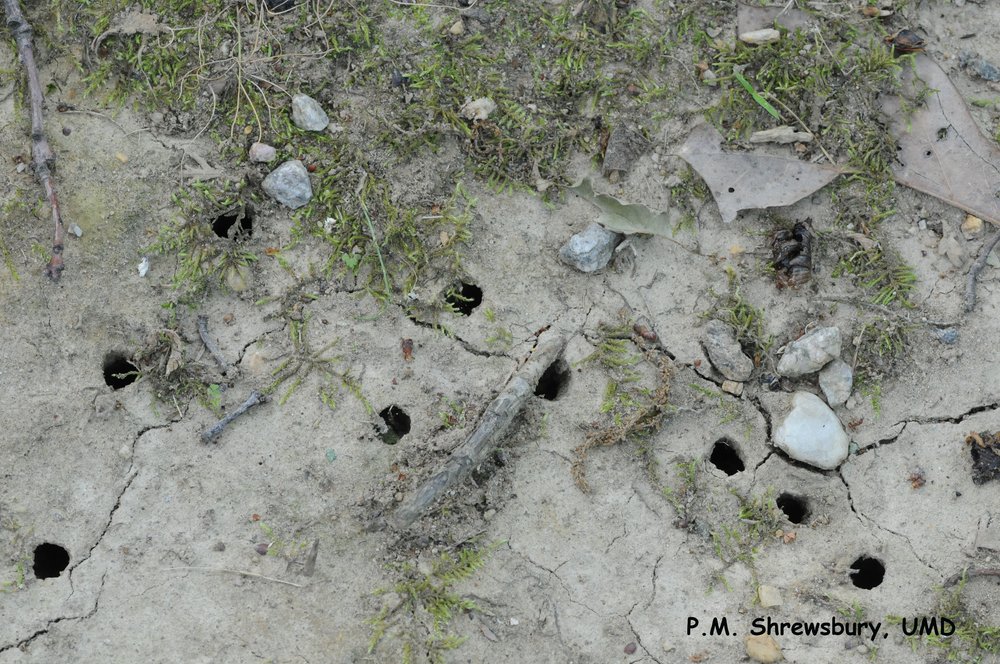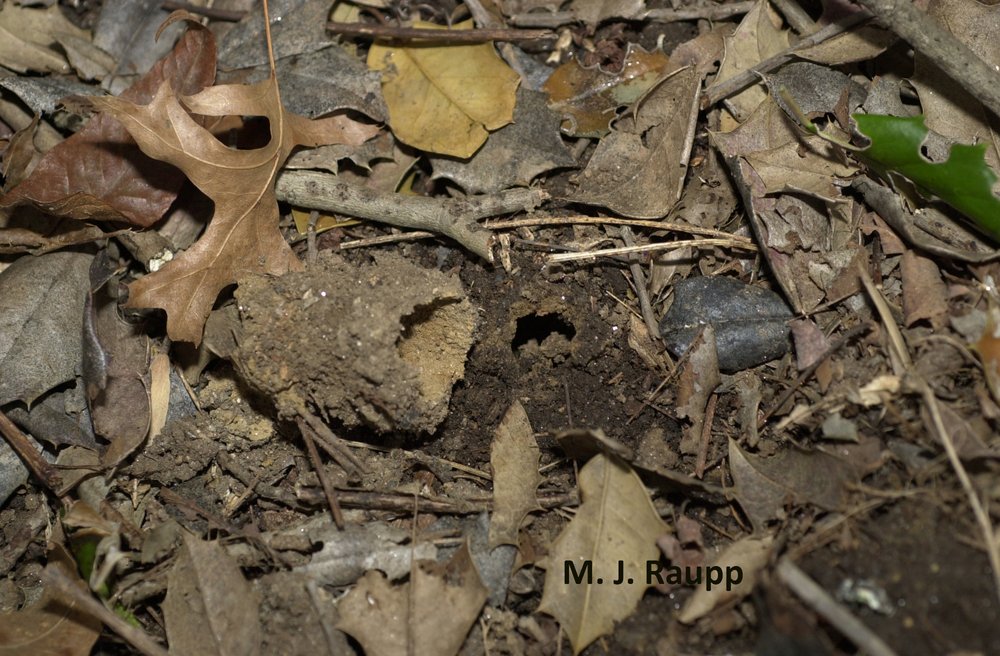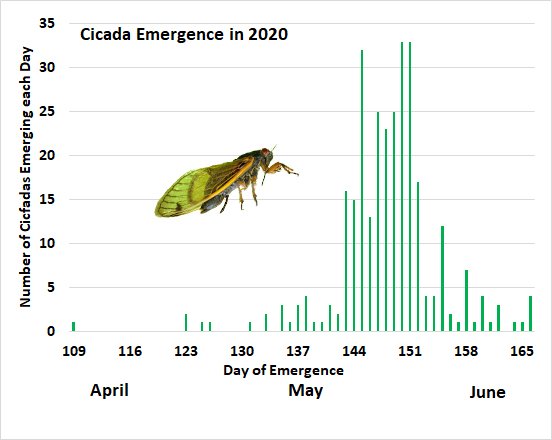
When you see dime-sized holes like these beneath a tree over the next few weeks, you’ve found a place where periodical cicadas will soon emerge. Image: Paula Shrewsbury, PhD
Here we are on April 8, 2024, donning special solar eclipse glasses to prevent UV rays from damaging our retinas, preparing to watch the solar eclipse. If, by chance, you miss this eclipse, well, you have to wait another 20 years and a few months to see another one here in the US. But, guess what, there is another amazing natural event taking place in a month that won’t happen again for another 221 years! In a broad swath of southeastern and mid-western states, the simultaneous emergence of two distinct broods of periodical cicadas will delight insect lovers and disturb many others. Earlier this year we broke the news that periodical cicadas would not be seen in Baltimore or Washington, DC, during this emergence. This week, following a deluge of questions from curious folks, we explore when and where periodical cicadas will be seen this year in the US.
Mud tubes and exit holes like these beneath trees are a sure sign you have found a place where cicadas will emerge this spring.

Under some soil conditions, cicadas build mud turrets over their exit holes before emerging from their subterranean nurseries.
When will we see cicadas? Scientists have determined that soil temperatures near 64 degrees Fahrenheit at a depth of about 7 inches signal cicada nymphs that the above-ground world is warm enough for them to emerge from their subterranean crypts, molt into adults, and flee to the treetops where they will find food and mates and, hopefully, escape from hungry beaks and jaws long enough to procreate and lay eggs in small branches. In a series of studies conducted back in 2017 in the DMV, we saw the first cicada emerge on April 19th near Towson, MD. This extreme outlier was the bellwether for the rest of the brood, which appeared full-force during the latter half of May. The two broods emerging this spring are Brood XIII, the Northern Illinois Brood, and Brood XIX, the Great Southern Brood. Brood XIII is an ensemble of three species, M. septendecim, M. cassini, and M. septendecula, that emerge on a 17-year cycle. Brood XIX is a collection of four species of periodical cicadas, Magicicada neotredecim, M. tredecim, M. tredecassini, and M. tredecula, that emerge on a 13-year cycle. Because Brood XIX is distributed in a broad swath from Maryland to Louisiana, it’s a safe bet that in southern states emergence will occur earlier than in Maryland and cicadas there may make their 2024 debut in late April or early May.

Brood X cicadas appearing one year early in the spring of 2020 provide clues as to when cicadas will appear in 2024 in Maryland and Virginia. The first cicada to emerge was seen on April 19 and the last on June 14. If 2024 is anything like 2020, outliers will appear in April, but the great cicada tsunami hits the last two weeks of May. By Memorial Day weekend the cicadapalooza will be rocking the treetops in 18 states around the country. Graph: Michael J. Raupp, PhD
This video first aired on April 19, 2021. Watch to see what is happening now in 18 states as periodical cicadas of Broods XIII and XIX get ready to emerge in 2024: "For seventeen years, nymphs of Brood X cicadas have been developing underground. While digging a hole in my yard in 2018, I discovered a quartet of periodical cicadas about 14 inches underground. Notice their white eyes and uniformly tan bodies. Last week, a periodical cicada not quite ready to emerge rested at the top of its exit gallery beneath a cinder block. Just behind its red eyes, the dorsal surface of the cicada is uniformly tan. On the evening of its emergence, notice how the dorsal exoskeleton of the fully developed cicada nymph bears two distinct black patches just behind its eyes."
Where will we see cicadas? Although periodical cicadas will not be seen in Baltimore or the District of Columbia, you won’t have to travel far too commune with these rascals. Southern St. Mary’s County in Maryland will host cicadas, as will several counites and cities in Virginia (see the list below). Historical records report cicadas as close as Alexandria, Stafford, and Williamsburg in Virginia. Cicada Mania, the amazing website for all things cicada, lists these locations as the ones where periodical cicadas will emerge in 2024.
Brood XIII
“Illinois places: Belvidere, Brookfield, Channahon, Chicago, Des Plaines River Trail, Downers Grove, Egermann Woods County Forest Preserve, Elmhurst, Flossmoor, Geneva, Glen Ellyn, Highland Park, Hinsdale, Homewood, La Grange, Lagrange Woods, Lake Forest, Lansing, Lincolnshire, Lisle, Lombard, MacArthur Woods Forest Preserve, Marseilles, McHenry, McKinley Woods, Morton Arboretum, Naperville, Northbrook, Ogden, Ottawa, Palos Heights, River Forest, River Grove, Romeoville, Ryerson Woods, Schiller Park, Thornton, Vernon Hills, Villa Park, Weaton, Western Springs, Westmont, Wonder Lake, and more.
Illinois counties: Bureau, Carroll, Cass, Cook, DuPage, Fulton, Grundy, Henderson, Henry, Jo Daviess, Kankakee, Lake, LaSalle, Livingston, Logan, Marshall, Mason, McHenry, McLean, Menard, Peoria, Putnam, Sangamon, Stark, Tazewell, Whiteside, Will, Winnebago, Woodford.
Iowa places: Atalissa, Solon, and more.
Iowa counties: Benton, Black Hawk, Bremer, Cedar, Dubuque, Henry, Iowa, Johnson, Jones, Linn, Louisa, Muscatine, Scott, Tama.
Wisconsin locations: Aurora University, Big Foot Beach State Park, Lake Geneva, Moraine Nature Preserve, and more.
Wisconsin counties: Crawford, Grant, Green. Rock, Walworth.
Indiana locations: Crown Point, Portage, Purdue-North Central, Valparaiso, and more.
Indiana counties: LaPorte, Porter, Lake.
Michigan: According to Cicadas @ UCONN (formerly Magicicada.org), Magicicada have been found along the border of Michigan and Indiana.”
Brood XIX
Alabama counties: Barbour, Bullock, Butler, Calhoun, Chambers, Choctaw, Clarke, Crenshaw, Elmore, Etowah, Greene, Lawrence, Limestone, Lowndes, Monroe, Montgomery, Russell, Sumter, Tallapoosa, Wilcox
Alabama cities: Huntsville, Lowndesboro, Talladega
Arkansas counties: Boone, Futon, Howard, Izard, Lawrence, Marion, Montgomery, Pike, Scott, Searcy, Sevier, Sharp, Washington, Yell
Georgia counties: Bibb, Bleckley, Butts, Columbia, Elbert, Greene, Harris, Houston, Jasper, McDuffie, Monroe, Muscogee, Oconee, Peach, Pulaski, Putnam, Richmond, Stephens, Taliaferro, Troup, Warren, Wilkes
Georgia cities: LaGrange, Lincolnton, Rome, Washington.
Illinois counties: Adams, Brown, Calhoun, Cass, Champaign, Clark, Clay, Coles, Cumberland, De Witt, Effingham, Fayette, Ford, Franklin, Gallatin, Hamilton, Hancock, Iroquois, Jefferson, Johnson, Marion, Massac, Morgan, Moultrie, Pike, Pope, Saline, Shelby, Vermillion, Washington, Williamson
Illinois cities: Charleston, Decatur
Kentucky counties: Allen, Caldwell, Christian, Trigg
Louisiana parishes: Caddo, Claiborne, Madison, Morehouse, Ouachita, Washington, Webster. Parish information comes from older literature, and might not be as accurate as recent information.
Maryland counties: St. Mary’s
Missouri counties: Adair, Boone, Callaway, Carter, Clark, Cooper, Dent, iron, Jackson, Knox, Louis, Lincoln, Macon, Maries, Marion, Montgomery, Morgan, Oregon, Osage, Pettis, Phelps, Ralls, Reynolds, St. Charles, St Francois, St Louis
Missouri cities: Columbia, Gerald, Manchester, Pevely, Poplar Bluff, St. Louis, Troy
Mississippi counties: Kemper, Newton
North Carolina counties: Buncombe, Cabarrus, Chatham, Davidson, Davie, Durham, Gaston, Guilford, Mecklenburg, Montgomery, Orange, Randolph, Rowan, Stanly, Union, Wake
North Carolina cities: Apex, Baldwin Township, Chapel Hill, Charlotte, Durham, Harrisburg, Mebane, New Hill, Pittsboro, Raleigh, Waxhaw
Oklahoma counties: McCurtain
South Carolina counties: Abbeville, Aiken, Anderson, Cherokee, Chester, Edgefield, Greenwood, Lancaster, Lexington, McCormick, Newberry, Oconee, Saluda, Union, York
South Carolina cities: Chester, Little Mountain, Rock Hill, Saluda, Winnsboro
Tennessee counties: Blount, Cheatham, Clay, Davidson, Grundy, Hamilton, Jackson, Loudon, Macon, Marion, McMinn, Meigs, Putnam, Rutherford, Sequatchie, Smith, Stewart, Summer
Tennessee cities: Gallatin, Lebanon, Nashville, Spring Hill
Virginia counties: Caroline, Gloucester, Halifax, James City, King and Queen, King William, Middlesex, New Kent, York
Virginia cities: Alexandria, Stafford, Williamsburg
If you don’t live in an area where cicadas may emerge, maybe you can plan a trip to visit these amazing creatures. If you don’t like hordes of large, noisy insects and you live in one of the areas listed above, well, it may be time to plan a vacation to the west coast. For cicada-philes, you can keep up with when and where cicadas are emerging by visiting the Cicada Mania website and participate in the incredible citizen-science project with the free Cicada Safari app. Another great source of information on periodical cicadas is the University of Connecticut’s periodical cicada information pages. Bug of the Week hopes you have a chance to enjoy the dual emergence of periodical cicadas this spring. If you don’t have a chance, don’t lament, Brood XIV returns for a limited engagement in parts of our region in 2025 and Brood II will put on a big show in 2030. Oh, and to watch cicadas, you won’t need special glasses, but you might want some ear protection. When the big boy band cranks it up, their racket will be really loud.
Acknowledgments
We thank Chris Carroll and Seth Borenstein for inspiring this episode. References used for this story include “The periodical cicada” by C. L. Marlatt, “Reproductive character displacement and speciation in periodical cicadas, with description of a new species, 13-year Magicicada neotredecim” by D. C. Marshall and J. R. Cooley, “Advances in the Evolution and Ecology of 13- and 17-Year Periodical Cicadas” by Chris Simon, John R. Cooley, Richard Karban, and Teiji Sota, and “Combining Data from Citizen Scientists and Weather Stations to Define Emergence of Periodical Cicadas, Magicicada Davis spp. (Hemiptera: Cicadidae” by M.J. Raupp, C. Sargent, N. Harding and G. Kritsky.
No comments:
Post a Comment